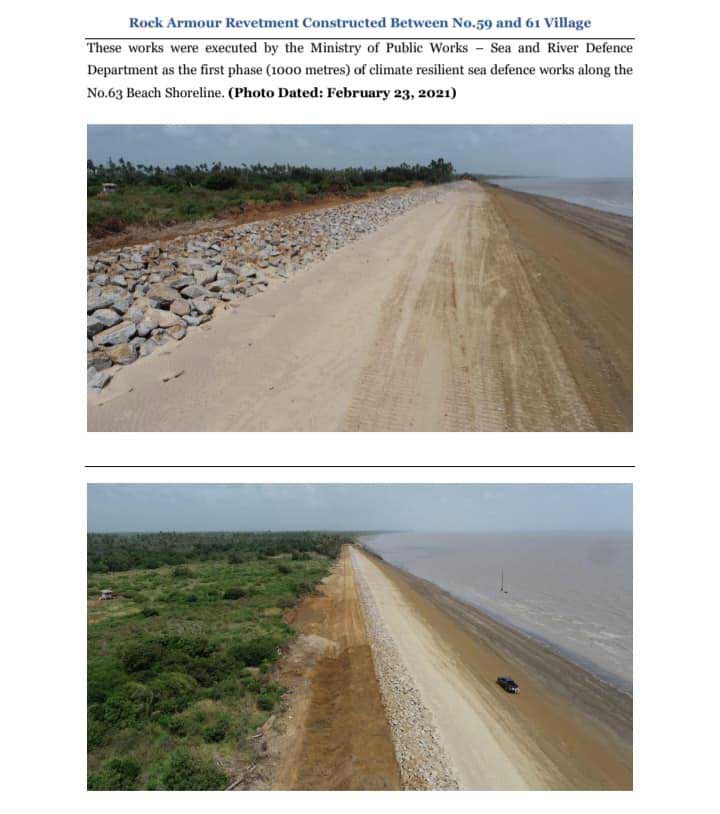The Ministry of Public Works [MPW] yesterday said that measures are being implemented to address the ‘localised erosion’ that has occurred at the No. 61 Village Beach Access and it denied that the sea defence in the area had failed.
The MPW said that it was responding to reports published in recent media articles and on social media platforms that a section of rock armour revetment at the No. 61 Village Beach Access was partially breached due to shoreline erosion and an imminent flood threat had been created for adjacent lands.
In the release, the Ministry said “it must be clarified that this area was an unprotected sand ramp and was not protected by a rock revetment as was reported. The affected area was retained in this state to be utilised as vehicular access to the No.63 Beach,” the release further stated. According to the ministry, the recent media reports and comments from a known community representative, which purport that there was a failure of a recently constructed sea defence structure are misleading. The ministry’s release said that the erosion of the beach access ramp was primarily due to high tides and that an adjacent 30-metre section of shoreline where temporary flood protection works were executed had also eroded due to displacement of the boulders by wave action.
However, according to MPW, the permanent rock revetment structure constructed between No. 59 to 61 Villages was assessed to be stable and continues to function as an adequate flood barrier. Recently executed flood protection measures, a natural, stable flood protection system comprising elevated sand banks and light nearshore vegetation has provided adequate flood protection along the section of the Corentyne shoreline between No. 50 to 63 Villages. These conditions allowed the area to be used as a recreational beach and minimized the need for the construction of hard flood defences. In 2020, a pattern of progressive erosion of the foreshore was observed which created the potential for complete loss of the natural sand ridge along the No.59-63 shoreline.
The MPW further detailed that in 2020, to prevent a breach of the sand bank and underlying clay embankment, the ministry’s Sea and River Defence Department initiated the first phase of rock armour revetment construction along a critical section of shoreline between No. 59 and 61 Village. A total of 1,000 meters of revetment structure was constructed, under two contracts totaling G$439,922,500 that remains functional and climate-resilient. The MPW release said that the eastern section of the works transitioned into the sand ramp beach access at the No.61 Village location and a temporary rock armour slope, covering a 30m section of shoreline was also constructed adjacent to the beach access ramp. For future programmed measures, the ministry said that the Sea and River Defence department will undertake interim reinstatement and erosion protection works at the beach access with a climate resilient design in the immediate future.
Additionally, according to the release, a programme of interventions has been developed for the phased execution of permanent flood protection works which will extend the rock armour revetment to adjacent sections of foreshore currently impacted by erosion. To ensure that the recreational use of the beach is preserved, a groyne field will be constructed to aid in sediment retention. These works, according to the release, will be initiated following the appropriation of the requisite funding in the 2024 Budget. In the short term (2024 – 2027), a holistic sustainable flood protection scheme will be developed for No.63 Beach which will provide climate-resilient sea defences, thereby reducing flood risk.
In Monday’s Stabroek News edition, Corentyne activist Gobin Harbhajan said that a section of the ‘riprap’ sea defence, which was completed in 2021, was falling apart leaving several farms and residential areas exposed. According to Harbhajan, “a riprap sea defence, more like a seawall with boulders… is to prevent water from coming into the lower land and a few weeks ago it began washing away from the Number 61 entrance.” Region Six’s Regional Chairman, David Armogan, disputed the activist’s claim and said on his Facebook page that the riprap structure was stable and in good condition providing adequate flood protection from Number 59 to Number 61 villages. Armogan pointed out that recent changes in weather patterns had seen a significant lowering of the foreshore from Number 58 to Number 62 villages and “As a consequence, 30 metres of boulder face protection (short slope, not riprap) to the Number 61 beach entrance were affected.”





